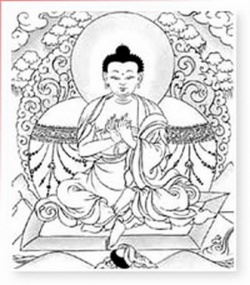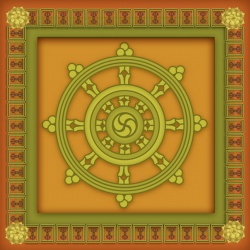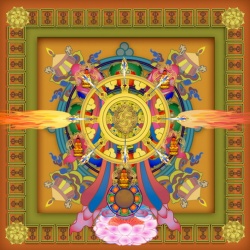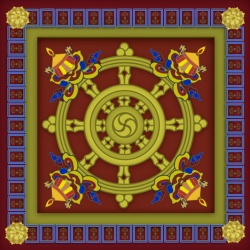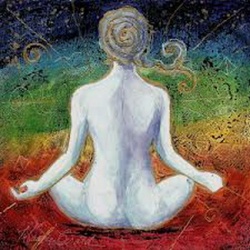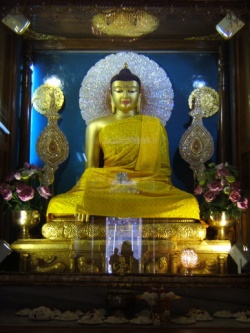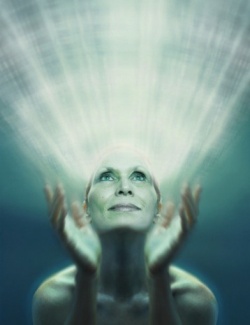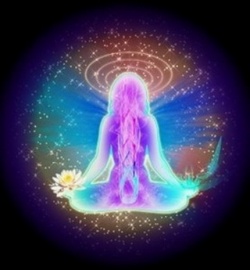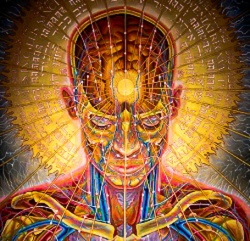Biographies: Pramodavajra, Regent of the Buddha
A Miraculous Birth
The biography of Pramodavajra has been handed down orally from very ancient times. The story therefore contains many legendary elements, and this we have to understand as we now retell it.
To start with, according to the legend, Pramodavajra Prince Uparaja and his wife Princess Alokabhasvati of Uddiyana had a beautiful daughter named Princess Sudharma. None of the old books tell us much about Princess Sudharma's personal appearance, but we can easily imagine her, fine of feature, small and delicate, similar to any of the petite golden skinned, dark haired girls that may be found in Swat in present times.
Her aristocratic features, coupled with the gentle grace of a religious nature, undoubtedly lent Sudharma a particular beauty. This gentle, sweet girl was by nature very devout and kind.
Thus when a strange, wandering holy man in white robes known as Kukkuraja, "King of the Dogs," came begging at the palace gate, the young Sudharma was deeply affected.
She recognized something unique in the personality of the mysterious Yogi that stirred her own religious yearning. As soon as she was old enough, she took the ordination of a Buddhist nun and went to live in retreat on a small island in the midst of Dhanakosha lake.1
According to the old books, one day while taking a purificatory bath on the shore of the sacred lake, the nun Sudharma beheld a pure mystical vision of a celestial white being.2 Some tales state the vision was that of a man, others say it was that of a white swan.
In either case, as an angelic white human figure or as a white divine swan, the old texts all agree in stating that the visionary being was ultimately an emanation of the supreme, being Vajrasattva.
In Princess Sudharma's mystical vision, the holy White Presence blessed her with special grace by placing a crystal vase3 three times on her head. Blissful prismatic light radiated from this visionary vase into Sudharma's pure heart, and she was temporarily transported into a state of mystical rapture.
It is said that while she was enraptured in the cosmic joy of this blessed vision, the heavenly Bodhisattva Adhicitta,4 an emanation of the self-existent Absolute (Vajra Sattva), entered Princess Sudharma's womb.
Therefore, according to the historical accounts available to us, the conception and birth of Sri Pramodavajra is rendered miraculous. Sudharma is portrayed as a perfect virgin maid, vowed to pure chastity, who becomes uniquely blessed to conceive a child.
The symbolic meaning behind the legend of the virginal conception and birth of Sri Pramodavajra is clear. Sri Pramodavajra was what in India is called an Avatar (from the Sanskrit ava, "descend", and tri, "to pass"), a term that signifies the special Incarnation of a divinely enlightened one in the flesh. We do not have to take the symbolism of virgin birth literally, for its poetic and mystical meaning to be acceptable to us.
Ten months after the miraculous conception of the holy Incarnation in the womb of the nun Sudharma, a male child was born. But instead of joy, the mother was overcome with shame.
After all, she was a virgin, vowed to religious chastity and a life of contemplation. And not only was Sudharma a nun, but also she was a royal princess. Her first thought—terrible though it was—consisted of finding some means to dispose of the unwanted child. Immediately the baby was born, she discarded his fragile little body by leaving it out on the local cinder pit to die.
Although the story is a terrible one, and the act wholly criminal, we can imagine the shame and compulsion that drove Sudharma to such extremes. How many a young woman, and especially a nun, finding herself pregnant, has not known the desire to avoid public attention through unburdening themselves of the baby, by abortion or other means? In Sudharma's century, for a young maiden to be subject to such terrible public exposure must have been unbelievably horrendous.
Sudharma had one devout maid servant, a young girl named Sukha Saraswati. This maid attended the Princess Sudharma during her spiritual retreat, and it was this maid alone who knew the secret of her pregnancy. Sukha Saraswati became hysterical when she observed that her mistress had disposed of the tiny baby. Three days following upon the birth, she slipped out on her own to the cinder pit to see if the poor infant was dead. To her amazement Sukha saw that the child was not only alive, but that he was happily playing in the ashes, surrounded in an aura of prismatic light.
Rushing back to her royal mistress, Sukha exclaimed with excitement: "O Lady! O Lady! Come and see! Your baby is alive." Sudharma was shocked. Now, riddled with guilt, she dashed along with her servant to the cinder pit.
There, just as Sukha had said, was the baby, gurgling with happiness, joyously propped up in the ashes like a little saddhu. All around his brown skinned, ash covered body, the miraculous glow of a heavenly rainbow light seemed to shine.
Seeing the baby for herself, Princess Sudharma underwent a complete change of heart. Where before she had been consumed by shame at having given birth to a child at all, now she only felt shame for the terrible act which she had done in attempting to get rid of it.
When Sudharma and her maid servant gathered up the precious child and returned with him, the very angels of heaven, so it is said, cried with joy. Sukha Saraswati, the maid servant, then told her mistress: "Truly, your baby is the son of the Buddha!"
So Sudharma named the child Akasavajra (Diamond of Space)6 and took him under her care.
Pramodavajra's Youth
When he attained his seventh year, the boy Akasavajra desired to discuss wisdom with the Pandits of Uddiyana. In this regard he was a remarkable child. He went to his mother and said, "Mother, it is my desire to converse with the scholars. Please give me leave to attend their Council."
But Sudharma thought that her son was too young and immature for the company of scholars. "You are a mere boy," she said. "It is not possible for you to enter the academy of the learned until you have matured." Unable to obtain her blessing, Akasavajra ran away on his own, and sought out the wise men at the court of Prince Uparaja of Dhanakosha.
When Akasavajra first appeared amongst these scholars (pandits) and monks (bhikshus) during a royal audience, Prince Uparaja was affronted by the youth's presence, thinking, "Who is this child?" The scholars and monks were likewise upset to find a seven year old presenting himself as one of their equals. But when the boy began to speak words of purest wisdom, the King's mood changed to awe.
"Who is this child?" the King asked his counselors. "Is he a special emanation of the Buddha or what?"
When summoned by royal command to speak before the whole academy of pandits, Akasavajra made respectful salutation and quickly demonstrated his innate wisdom and profound understanding of the Buddha's doctrine. Overwhelmed by the child's brilliance, all the wise men of the land proclaimed him a prodigy. They gave him the ordination of a novice and bestowed on him the name of Prajnabhava, meaning the one who is a being (bhava) of peerless Wisdom (prajna).
Later, when his studies were complete, the young man received the full ordination of a Buddhist monk and was given the title of Master (acarya) from the King. Thus he was known as Acarya Pramodavajra.7 It is by this name (or the familiar Tibetan translation, Lopon Gah-rab Dorje) that he is best known.
Great Enlightenment
As a Buddhist monk , Acarya Pramodavajra lived a purely monastic, disciplined life for many years. This discipline as a monk prepared him for the contemplative life. At first he studied many texts, many fine scriptures and profound metaphysical treatises, acquiring a vast wealth of knowledge. Then with time he more and more turned away from scholastic studies, to sit in quiet meditation. He meditated in his monastery cell and in the caves and forests of the Kingdom of Uddiyana.
At some point in the maturation of his spiritual evolution, he received the blessed Empowerment and Transmission of the profound Mahayoga teachings of the Secret Matrix Tradition (Guhyagarbha-tantra) from the renowned personal guru of the King of Uddiyana, the great white-robed saint Mahasiddha Kukkuraja. After that he retired into retreat on the slopes of Mount Suryaprakasa8 in the north, where he performed mantra practice in a small grass hut.
Kukkuraja's instruction had been very direct. "Everything without exception is the Body-Speech-Mind of the Buddha," he had said. "This Body-Speech-Mind is all-encompassing. Thus know your ultimate identity to be Vajrasattva, the Body-Speech-Mind of the Buddha."
In his thirty-second year, Acarya Pramodavajra came face to face with Vajrasattva: he attained complete Enlightenment. Simultaneously the earth quaked and the sky was filled with celestial sound.
Pleasure and pain lost their sway over him. The emotional strings of desire and fear fell away, and he found himself complete, in need of nothing. Utterly transformed by pure vision, his whole being was flooded with the grace of great bliss, and his mind awoke through the cosmic empowerment of primordial Awareness.9 Thus, in one instant, he grasped full insight into Absolute Totality, the omniscient state of Dzogchen Mahamudra.
Now, the holy enlightened sage Sri Pramodavajra held within his intellect all of the wisdom, all of the insightful understanding, all of the unique knowledge of what later became known as the Dzogchen Doctrine, and which, when finally written down, would consist of six million, four hundred thousand lines of Sanskrit verse. This Doctrine concerns the mysteries of Creation, the development of Man, the nature of Ultimate Reality (dharmata) and the means of acquiring Enlightenment by cutting through to a clear view of that Reality. This Doctrine, or optimal View, has been rightly called the innermost essence of Buddhism.
But at first when the word went forth that the unique sage Sri Pramodavajra was teaching a new Doctrine, a non-causal doctrine, not everyone was pleased. A foreign king holding extremist views sent an assassin to kill the enlightened Master.
Indeed, the era during which we must suppose these events to have occurred was in fact one of great social upheaval and turmoil. In 690 A.D. the lady Wu Chao had managed to usurp the throne of China and have herself made Emperor (Huang-ti), after having been proclaimed, by an ambitious court monk, as an Incarnation of the future Buddha Maitreya. By 669 the Western Turks were undergoing considerable political turmoil and Tri Du-srong, the emperor of Tibet, was actively extending his power in Central Asia by means of continuous bloody warfare and pillage. The neighboring Turkish Shahi kingdoms of Kapisa (Shambhala) and Uddiyana were also both being hard pressed on their southwesterly flank by the inexorable expansion of the southern Arab Moslems.
Ramashankar Tripathi tells us that although "hardly anything is known of the Turki Shahis" during this era, nevertheless it is certain they were carrying on "intermittent wars with the Arab invaders from the seventh to the middle of the ninth century A.D."10
By 711 A.D. Moslem raiders would descend on Sind under the command of Muhammad ibn Qasim. The Middle East was in turmoil and continuous political tensions swept the settled regions of Central Asia. It need not be surprising, therefore, that in this time of crisis an attempt was made on the life of the holy father of our sacred tradition.
It was around the same time that a wandering trader in fine cloth, from the Valley of Cina, came to Uddiyana. By chance the young trader met Acarya Pramodavajra and, impressed by the Master's saintliness, asked to receive transmission (agama) and empowerment (abhiseka). Perceiving that here was a vessel worthy to receive the most excellent teachings, Sri Pramodavajra initiated the young man into the meditation and mantra practice of Vajrasattva. The young man's name was Simha, the Lion. Later, as Sri Simha, he would be known as a main lineage holder of the Master's teachings.
Promulgating the Doctrine In India
In consequence of the attempt on his life, which proved unsuccessful only due to his miraculous foresight, the Master departed for Mount Malaya in the Salt Range to the south of Uddiyana. At some point around this time he gave up the discipline of a monk, and wandered freely in the white garb of a yogi. It was not long after this that he began to attract a small following of male and female disciples. On Mount Malaya he was assisted by three Enlightened-women (dakini) disciples in transcribing into book form the secret doctrines of Dzogchen. The work of composition was only concluded after three years of unstinting labour on the part of Sri Pramodavajra, the Dakini Vajradhatu, the Dakini Suvarna Shankara, and the Dakini Anantaguna. When the work was finished they stored it in the archives of a cave-temple known as the Dakini-abhivyaktabhava, or the " Dakini's Source of Manifestation" , where it was held in the safe-keeping of the Dakini Cittasana.11
With the certain knowledge that the precious, supreme Secret Doctrine was secure, Sri Pramodavajra then proceeded on pilgrimage to Vajrasana (modern Bodh Gaya), the site where centuries earlier Buddha Sakyamuni had attained his enlightenment. With his mystic consort, the Lady Suryakirana, he took up residence in the Cool Grove(Sitavana) cremation ground, which lies about a mile or so northeast of Vajrasana.12;
A large white stupa graced the Cool Grove cremation ground with its aesthetically beautiful presence. This was the Shankarakuta stupa, which happens to be the same name as the temple and stupa in Uddiyana near where the Master had been born. There, in the Cool Grove, at the base of the white Shankarakuta stupa, Sri Pramodavajra lectured on the mysteries of the Supreme Truth to many beings, both male and female.
One of the disciples who came to sit at the feet of the divine Master was the Mahapandita (" Great Sage" ) Manjusrimitra. Eventually Sri Manjusrimitra became the guru's chief successor and spiritual regent.
The Master's Last Testament
Sri Pramodavajra spent the rest of his days teaching at the Cool Grove and at various spots in and around Bodh Gaya. Occasionally he and his band of male and female disciples would wander northwards to the hotsprings that are near the Vulture's Peak, not far from Patna.
Eventually the Master's body weakened with age, as is the fate of all who walk this earth. Then one day, without the slightest pang of remorse, Sri Pramodavajra passed out of this world.
When Sri Pramodavajra departed from earthly life, he left his Last Testament in the hands of his chief disciple Manjusrimitra. This highly treasured Last Testament consists of a tiny fragment of script that has come down to us in its Tibetan version. Translated into English, it is roughly as follows:
Three Statements Pointing To Intrinsic Awareness
Direct introduction to one's own nature.
Direct recognition of that singular state.
Direct continuation through faith in liberation
This Testament, short though it is, was composed as a means of transmitting from generation to generation a special fragment of spiritual information between initiates.
Footnotes
1 In Tinley Norbu's version of this story, Sudharma's name is "Parharani" and she is said to be the daughter of Asoka (268-231 B.C.), the great Emperor of India. Needless to say, this is quite anachronistic and historically meaningless.
2 Dudjom Rinpoche says that Sudharma's vision (or "annunciation" and "miracluous conception") occurred not while bathing, but in a dream while asleep.
3 The visionary vase (kalasha) was imprinted with the seed phonemes OM AH HUM SVA HA of the five-fold Buddha pleroma (tathagata-mandala), symbolizing the holy presence of the essential nature of the Transcendental.
4 Adhicitta, primordial mind, is referred to in the legend as the "Jina-putra" or divine Son of the absolute Buddha. The primary aim of the Buddhist legend of Sri Pramodavajra's immaculate conception is to emphasize that this Master was a perfect living embodiment of Vajrasattva the highest principle of enlightenment. The conception of Pramodavajra is said to have occurred on the eighth day of the 1st summer month in the Wood Ox Year. But which Wood Ox year? Relying on the tradition that places these events 360 years after the historical parinirvana of Buddha Sakyamuni, the year would be 120 B.C. Tibetan scholars simply accept this date as authoritative. However, the Turkish Shahi kingdom of Uddiyana did not exist at that early date. Western scholars, seeking to find a year compatible with the historical context, have therefore suggested the Wood Ox year of 665 A.D. This would then represent the true year of Pramodavajra's birth.
5 Yogananda, Autobiography of a Yogi, Self-realization Fellowship, Los Angeles, 1981. Yogananda states that the supreme Avatar " is un-subject to the universal economy; his pure body, visible as a light image, is free from any debt to Nature... The casual gaze may see nothing extraordinary in an avatar's form; but, on occasion, it casts no shadow nor makes any footprint on the ground. These are outward symbolic proofs of an inward freedom from darkness and material bondage. Such a God-man alone knows the Truth behind the relativities of life and death."
6 The name Pramodavajra (Tib: Gah-rab Dorje) was not acquired until later. His original name was Akasavajra (Tib: Namkhai Dorje), which might also be translated as "heavenly sceptre" or the 'Diamond' that has come down from Space. He is said to have received the nickname Vetala-sukha (Tib: Ro-langs-bde-ba), "Blissful Resurrection" or Ro-langs-thal-mdog, the Ashen Resurrection. The term "Vetalasukha" can also be seen to forecast the miracle of Pramodavajra's post-death resurrection.
7 Tib: Gah-rab Dorje,the name by which he is best known. We possess no surviving Sanskrit record of his name, and therefore a number of variant reconstructions have been offered. The most likely is that suggested by my divine Guru, Kyabje Palden Sherab Rinpoche, namely "Pramodavajra" which means, as in the Tibetan, the " Diamond of Supreme Joy." Prof. Guenther has suggested the equally valid "Pramudita-vajra". Prof. Hanson-Barber has suggested "Anandavajra" but ananda can hardly be taken as a translation of the Tibetan gah-rab. In some texts "Prahevajra" is given, which is equally incorrect.
8 Suryaprakasa means the mountain of the " dawning of the sun" or " Mt. Sunrise." It is described as being in the North. Which of the many great peaks of the Hindu Kush or Karakorum this is today cannot be ascertained, but it is possible that the mountain was the sacred peak (Nanga Parbat?) in Hunza on which Jesus Christ (Isa-Masiha), surrounded by the disc of the sun, is said to have appeared to a king of the Sakas, according to the Bhavisya purana. The other sacred mountain in Uddiyana was Mt. Ilam (referred to as Mt. Ilo by the Tibetans), which lies south-east of the old capital. It is hard to say what "North" means in this context. It could be taken as North within the Dhanakosa district, or north in the sense of up the Swat River. It is also possible that the mountain was the renowned Tirich Mir, North of the Lotkho Valley in the Chitral.
9 The "Empowerment of Awareness" (Tib: Rigpai rTsaldbang) is a technical term in the Dzogchen tradition, meaning the direct introduction of the devotee to the intrinsic nature of his own mind-essence. When the Dzogchen Master bestows this empowerment, he or she directly introduces the student to his or her own nature. In the story of the advent of Dzogchen as a teaching on this planet, it is said that Sri Pramodavajra received this empowerment(abhiseka) from Vajrasattva, the Supreme Being. He thus became capable of passing it on to his disciple, and so on. This empowerment of the creative energy (rTsal) of innate Awareness is what truly consists of the actual transmission, from generation to generation in an intimate Master-disciple relationship, of the precious Yogacara lineage. This is known as the heart to heart transmission, because it is communicated mystically from the heart of the Master to the heart of the disciple.
10 Ramashankar Tripathi, History of Ancient India, New Delhi 1985. The last Buddhist ruler in Gilgit was Sri Badat in the 7th century. His slayer and successor was a Persian adventurer named Azur Jamshed, who forcibly married Sri Badat's daughter. It is therefore likely that the " foreign king with extremist views" who sent an assassin against Sri Pramodavajra was this same Moslem usurper. West of Gilgit there is a large standing Buddha image carved on a cliff face in Kargah Nala that dates from Sri Pramodavajra's era. On up Shuko Gah there are the ruins of a monastery and stupa, and a cave where Buddhist birch bark texts (now known as the Gilgit Manuscripts) were discovered in the 1930s. To the south of Gilgit stands Nanga Parbat, the eighth highest mountain in the world, its north face stepping down 8,000 metres to the Indus River. Native inhabitants to this day still believe that sacred Nanga Parbat (or Dia-mir in the local dialect) is topped by a crystal palace occupied by fairy spirits, or capricious Dakars and Dakinis, and guarded by cloud serpents.
11The term Dakini (Tib: Kha-dro-ma) used in the tantras applies to a female Buddha or Vidyadhara, a woman who has attained enlightenment. On Mount Malaya the Master was assisted by three such women in writing down the voluminous text of the Secret Doctrine, whose names may be interpreted as follows: the Dakini of the Diamond-expanse (Vajradhatu-dakini); the Dakini of Golden-blessings (Suvarna Shankara-dakini); and the Dakini of Endless Qualities (Anantaguna-dakini). Mount Malaya (often conflated with the mountain of Ugra, known in Tibetan as drag-shul-can) has been incorrectly designated by Dudjom Rinpoche as Adam's Peak in Sri Lanka (Ceylon). The ancient name Malaya used to apply to the whole range of mountains west of Malabar (i.e., the Western Ghats) in southern India, which are famous for their sandalwood trees, and ancient Malayacala (Mt. Malaya) may have been one of the main peaks in that range. That Mt. Malaya would appear to be the same as Mons Bettigo mentioned as a home of the Magi by Ptolemy of Alexandria in the second century A.D., where he states: " In like manner the parts under Mount Bettigo are occupied by the Brakhmanai Magoi as far as the Batai, with the city of Brahme..." A popular reference to Mt. Malaya is to be found in the Sadharma-lankavatara-sutra, where Lanka is in fact a citadel (puri) located on the hieghts of Mt. Malaya, ruled over by the mythical King Ravana of the Ramayana epic. But in the tantric period there was, however, a Lankapuri in the West of India, south of Uddiyana, which was identified by Hiuen Tsiang as Simhapura, with its capital at Kataksha (modern Ketas) in the Salt Range south of Rawalpindi. It hardly bears mention that Simhapura and Lankapuri are synonymous names. In a notation to folio 96A of Taranatha's History of Buddhism in India, V.P. Vasil'ev confirms the old tradition of the 84 Mahasiddhas that the Kingdom of Uddiyana was divided between two countries, to the North and South. To the North, it bordered on the land of Shambhala (i.e., the Kingdom of Kapisa), while to the South was Lankapuri. A tenth century king of Uddiyana, named Indrabhuti, had a sister called Laksminkara, who married King Jalendra of Lankapuri. It was to this Lankapuri, with its famous Malaya mount, that Pramodavajra traveled when he left Uddiyana.
12 Today the site of the famous Cool Grove can still be found. More or less unknown by the multitude of tourist visitors who come each year to Bodh Gaya, it is nevertheless an important meeting place for wandering Buddhist and Hindu yogis. Sitavana is still a pleasant grove of tall trees. There are some stones amongst the grass, which I take to be the last remains of the large Shankarakuta stupa that used to stand there. It was truly from this sacred site that Pramodavajra’s teachings were originally promulgated, and it was again from this same site 1260 years later that the Indian sage Kunu Rinpoche re-promulgated them to the leading Masters of our age.
